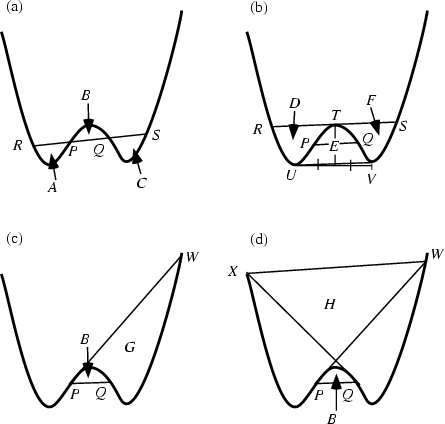Quartic Curve
A general plane quartic curve is a curve of the form
| (1) |
The maximum number of Double Points for a nondegenerate quartic curve is three.
A quartic curve of the form
| (2) |
| (3) |
| (4) | |||
| (5) |
This transformation is a Birational Transformation.

Let ![]() and
and ![]() be the Inflection Points and
be the Inflection Points and ![]() and
and ![]() the intersections of the line
the intersections of the line ![]() with the curve in Figure (a) above. Then
with the curve in Figure (a) above. Then
| (6) | |||
| (7) |
In Figure (b), let
| (8) | |||
| (9) |
In Figure (c), the tangent at
| (10) |
| (11) |
References
Coxeter, H. S. M. ``The Pure Archimedean Polytopes in Six and Seven Dimensions.'' Proc. Cambridge Phil. Soc. 24, 7-9, 1928. Du Val, P. ``On the Directrices of a Set of Points in a Plane.'' Proc. London Math. Soc. Ser. 2 35, 23-74, 1933. Honsberger, R. More Mathematical Morsels. Washington, DC: Math. Assoc. Amer., pp. 114-118, 1991. Schoutte, P. H. ``On the Relation Between the Vertices of a Definite Sixdimensional Polytope and the Lines of a Cubic Surface.'' Proc. Roy. Akad. Acad. Amsterdam 13, 375-383, 1910.
- Hexadecagon
- Hexadecimal
- Hexaflexagon
- Hexagon
- Hexagonal Number
- Hexagonal Pyramidal Number
- Hexagonal Scalenohedron
- Hexagonal Tiling
- Hexagon Polyiamond
- Hexagram
- Hexagrammum Mysticum Theorem
- Hexahedron
- Hexahemioctahedron
- Hexakaidecagon
- Hexakis Icosahedron
- Hexakis Octahedron
- Hex Game
- Hexlet
- HexLife
- Hex Number
- Hexomino
- Hex (Polyhex)
- Hex Pyramidal Number
- Heyting Algebra
- H-Fractal